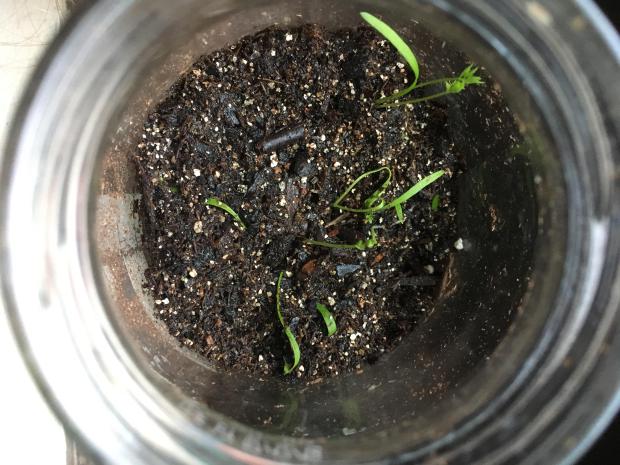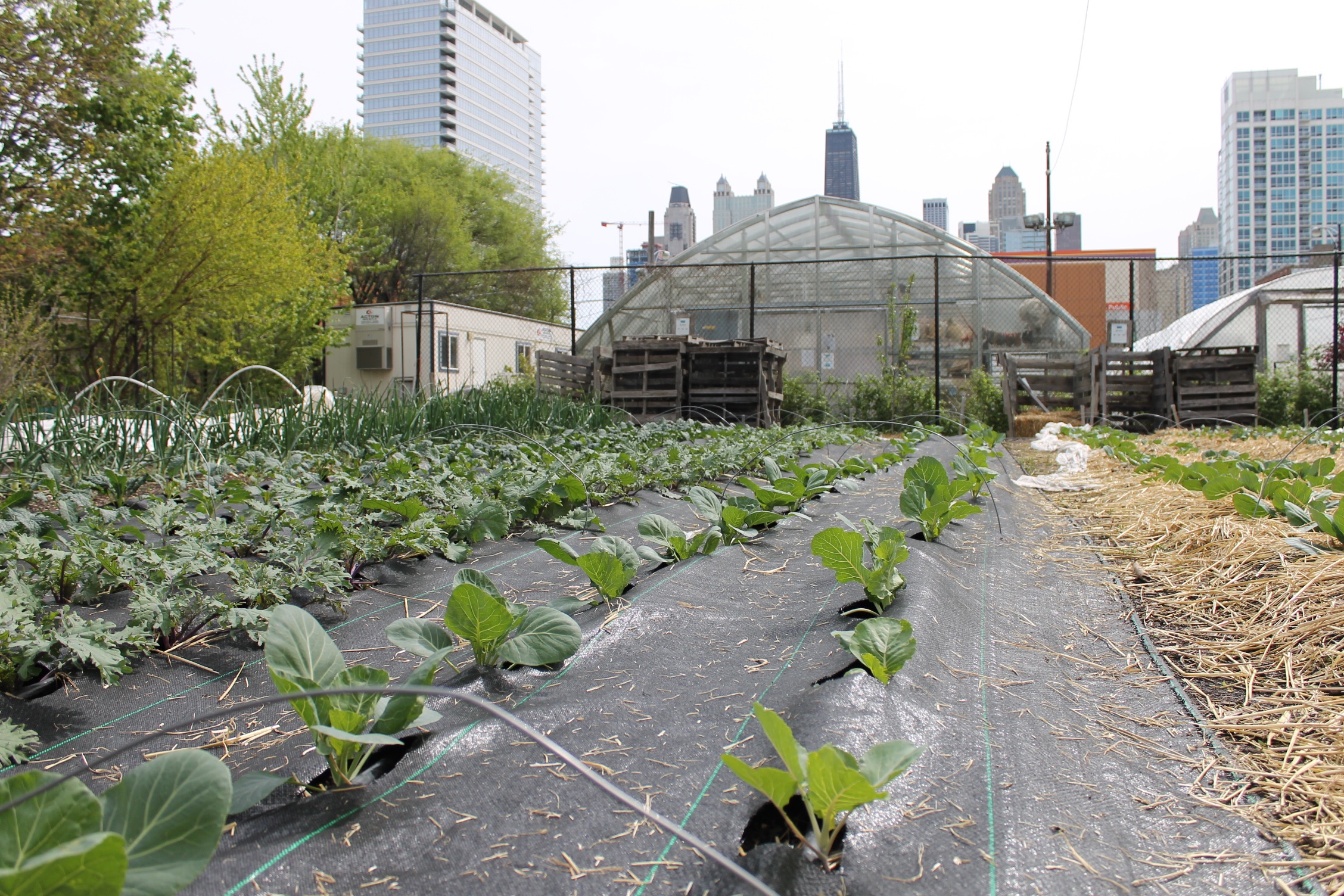Bushel, detassel, fungicide, nodule—these are all words I was very familiar with from a young age. I’d drive through fields rouging crops, discussing yields and even talking about how plant-based proteins would help provide protein to our growing world.
What I didn’t realize, once I moved from Iowa to Chicago, was that those terms weren’t as common as I thought. Was walking through rows of corn and removing the tassels not everyone’s first job?
The most “farm talk” I had in Chicago was whether the cucumbers in Whole Foods were non-GMO or not, and over the years I began to wonder if I had completely lost touch with the agricultural world. However, what I didn’t realize was it was growing all around me.
From the strong focus on urban agriculture within the Englewood neighborhood to Gotham Greens, the world’s largest rooftop garden, Chicago is quietly leading the nation in urban food production. Changes to the Chicago Zoning Ordinance are allowing community gardens and urban farms to develop all across the city.
But what is urban farming? Exactly what it sounds like. It’s the growing or producing of food in a city or heavily populated town. It’s important to note that urban farms are different than community gardens because the products are sold, as opposed to being grown for personal consumption or sharing.
How is Chicago leading the way?
According to the Chicago Tribune, the city has been able to lead the urban farming game with the help of a $1 million federal grant. This grant was one of 45 projects awarded (a total of $26.6 million last year) through the U.S. Department of Agriculture‘s annual Conservation Innovation Grants.
Additionally, through its “Growing for Chicago” initiative, the city plans to organize urban farming efforts, create partnerships with existing nonprofits and help prepare vacant land in neighborhoods for farming.
Jeremy Lozano at Chicago Lights Urban Farm. (Lauren Sharp, 14 East)
Allie Williams, a program assistant and volunteer coordinator of the Chicago Lights Urban Farm, said transforming vacant lots is just the start of how urban farms reach neighborhoods.
“Even if people aren’t coming into the farm, we come to them,” she said. “We have a mobile food trailer on a bike, so we’ll go around the neighborhood selling the produce. It’s not just the lot that’s transformed. It’s the entire community.”
Haven’t heard of any urban farms in your area? Look again. According to the Chicago Urban Agriculture Mapping Project there are over 800 growing urban agriculture sites in Chicago. This total includes rooftop and community gardens, orchards, urban agriculture organizations, farm stands, and more.
Top 10 urban farms in Chicago. Map by Lauren Sharp.
Is urban agriculture “farm”-fetched or a necessity?
Many articles have claimed that urban farming is both simple and sustainable. Although the U.S. Department of Agriculture doesn’t track numbers of city farmers, demands and funding for startups affirm that business is flourishing.
Take Big Delicious Planet for example—with only eight raised vegetable beds in a small corner of their parking lot, this West Town restaurant harvested close to 3,000 pounds of vegetables in 2016. That’s enough food during the growing season to feed 50 people, three servings a day.
Luke Chamberlin, the head farmer at Big Delicious Planet, said that this year they hope to harvest 5,000 pounds — putting everything they grow directly into their kitchen and then onto plates in their neighborhood.
Although our nation’s president remains skeptical about climate change, agricultural experts say they are continually adapting to the change in climate through planting times, genetic selection, crop rotations, fertilizer management and more. To them, climate change is evident through their modifying of agriculture processes.
According to a recent assessment by the U.S. Climate Change Science Program, change in temperatures and temperature extremes are affecting “snowmelt, runoff, evaporation, and soil moisture; the frequency of disturbances, such as drought, insect and disease outbreaks, severe storms, and forest fires; atmospheric composition and air quality; and patterns of human settlement and land use change.” Thus, climate change leads to numerous direct and indirect effects on U.S. agriculture.
This epidemic produces an increased focus on and proliferation of urban agriculture.
What if I don’t believe in climate change?
Even if saving the planet isn’t super high on your to-do list, urban farming has more benefits besides eco-friendly food production. Chamberlin, who grew up in a farm town but moved to the city three years ago, believes there are many reasons urban farming can benefit people.
“You can make use of vacant lots and the space, employ people, give people more autonomy if they are growing their own food and cheaper access to food since it’s coming from their own neighborhood,” said Chamberlin.“People gain great life skills . . . honestly, I can’t imagine [urban farming] not continuing to grow because it’s such a wholesome thing.”
Through innovative techniques, food quality, job creation, and food security, urban farming adds more to Chicago than aesthetic appeal. It contributes to the health of the city’s entire ecosystem.
At the Chicago Lights Urban Farm, Williams agrees. To her, the food produced is just as important as the young children they help while producing it.
“We bring in youth from neighborhoods in Chicago that probably don’t have access to produce, because they are living in food deserts and areas like that,” she said. “A lot of these kids would never normally be exposed, or understand, where their food comes from. Along the way we are also providing them with job skills, financial literacy, it’s a very wide spectrum.”
Farming isn’t one size fits all
While Big Delicious Planet and Chicago Light Urban Farm are two of the largest urban farms in Chicago, urban agriculture can come in all sizes. Jessica Harris, a junior at DePaul University, has started growing her own plants in her dorm room.
“I’ve got some carrots and beans growing right now,” she said. “Not only am I growing food for myself, it’s just awesome to watch the process. I’m learning and getting free food, too. Plants are so cool.”

Harris’ bean plant growing in her dorm room. (Lauren Sharp, 14 East)
Like a small plant growing through the cracks of a sidewalk, Chicago’s urban farming scene is a hope-filled industry in a hard city. Yet, it is steadily becoming a source of jobs, direction for low-income students, and a source of food in some of the poorest neighborhoods on the South and West Sides.
“Chicago has so much open space, so much opportunity for growing. There is also a lot of food discrepancy in people’s access to food,” said Chamberlin. “Even in my three years here, urban ag has been growing and with all the need in the city I can’t imagine it stopping.”
And while rooftop gardens may remain much different than the millions of acres of farmland in Iowa, rooting myself in this urban agriculture scene has been a reminder for me that home can be found whenever you’re growing.
Header photo by Lauren Sharp









Map of sustainable produce options – Green Print Chicago
6 February
[…] Urban farms have also taken off within the past few years. They’re a great resource for the city as many of them, such as Chicago Lights Urban Farm, are committed to providing economic opportunities and educational resources all while making fresh produce and green spaces more accessible for neighborhoods across the city. […]